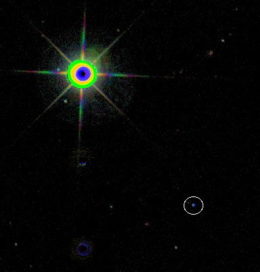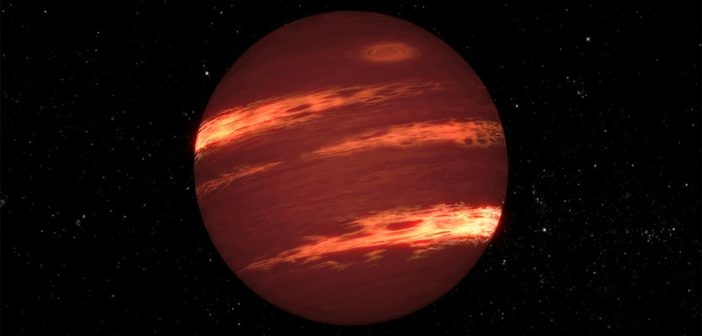Nearby, cool dwarfs offer us the unique opportunity to learn more about the atmospheres of planetary-mass bodies. In a new study, Hubble observations shed some light on the clouds of one such object.
Looking for Variability

A false-color image of the Ross 458 system. The bright source in the top left is the binary star system; the planetary-mass brown dwarf companion Ross 458C is circled on the bottom right. [UKIDSS]
When we directly image planet-like bodies using high-resolution telescopes, we can look for variability in the light from the body over time. Regular, periodic variability can indicate the presence of clouds in that object’s atmosphere — and observations of the variability can reveal information about the cloud structure and composition.
An Atlas of Clouds
To this end, a large Hubble Space Telescope Treasury program was begun in 2015: Cloud Atlas. The program’s aim is to use high-precision, time-resolved Hubble photometry and spectroscopy to explore the atmospheres and clouds of exoplanets, planetary-mass brown dwarfs, and more massive brown dwarfs — bodies with typical temperatures between 800 K and 1,700 K.
There are two major steps to the Cloud Atlas project:
- Construct a broad sample of observed planets and brown dwarfs showing variability. This will ultimately allow us to compare the cloud maps between different objects and determine how cloud properties depend on things like a body’s temperature and size.
- Conduct detailed studies of the most interesting objects in this sample, using longer follow-up observations that cover complete rotations of the bodies.
In a recent publication led by Elena Manjavacas (W.M. Keck Observatory; The University of Arizona), the Cloud Atlas team describes their detailed observations of the planetary-mass brown dwarf Ross 458C as part of the latter half of this project.

Observations of Ross 458C’s light curve over time in three different bands (white, top; narrow J-band, center; narrow H-band, bottom) reveal a distinct periodic variation fit by a sine function. [Adapted from Manjavacas et al. 2019]
Clouds on a Planetary-Mass Companion
Ross 458C is a T8 brown dwarf that orbits a binary system less than 40 light-years away. This cool object lies near the blurry line between brown dwarf and planet, representing the coldest dwarf yet to undergo detailed cloud studies.
Manjavacas and collaborators’ long observations of Ross 458C over seven consecutive Hubble orbits — during which 77 spectra were captured — revealed variability in the dwarf’s spectrum at a level of 2.62 ± 0.2% over the wavelength range of 1.1–1.64 µm. This modulation suggests the dwarf’s rotation period is somewhere around 6.75 hours.
By exploring how the dwarf’s variability changes across different wavelengths, the authors hope to be able to understand what its clouds are made up of and how the cloud structure is distributed in the atmosphere. Current best estimates from modeling suggest that these may be heterogeneous sulfide clouds (very different from Earth’s clouds of water!) — which could also explain the reddish color of Ross 458C.
The discovery of Ross 458C’s rotational modulations is important in and of itself: it suggests that clouds are typical even in the atmospheres of the coolest dwarfs. We can look forward to plenty of follow-up work further exploring the atmosphere of a planetary-mass companion with this convenient laboratory.
Citation
“Cloud Atlas: Rotational Spectral Modulations and Potential Sulfide Clouds in the Planetary-mass, Late T-type Companion Ross 458C,” Elena Manjavacas et al 2019 ApJL 875 L15. doi:10.3847/2041-8213/ab13b9

2 Comments
Pingback: AAS Nova – New
Pingback: Daily Study Log (2019-05-01) | Study Astrophysics